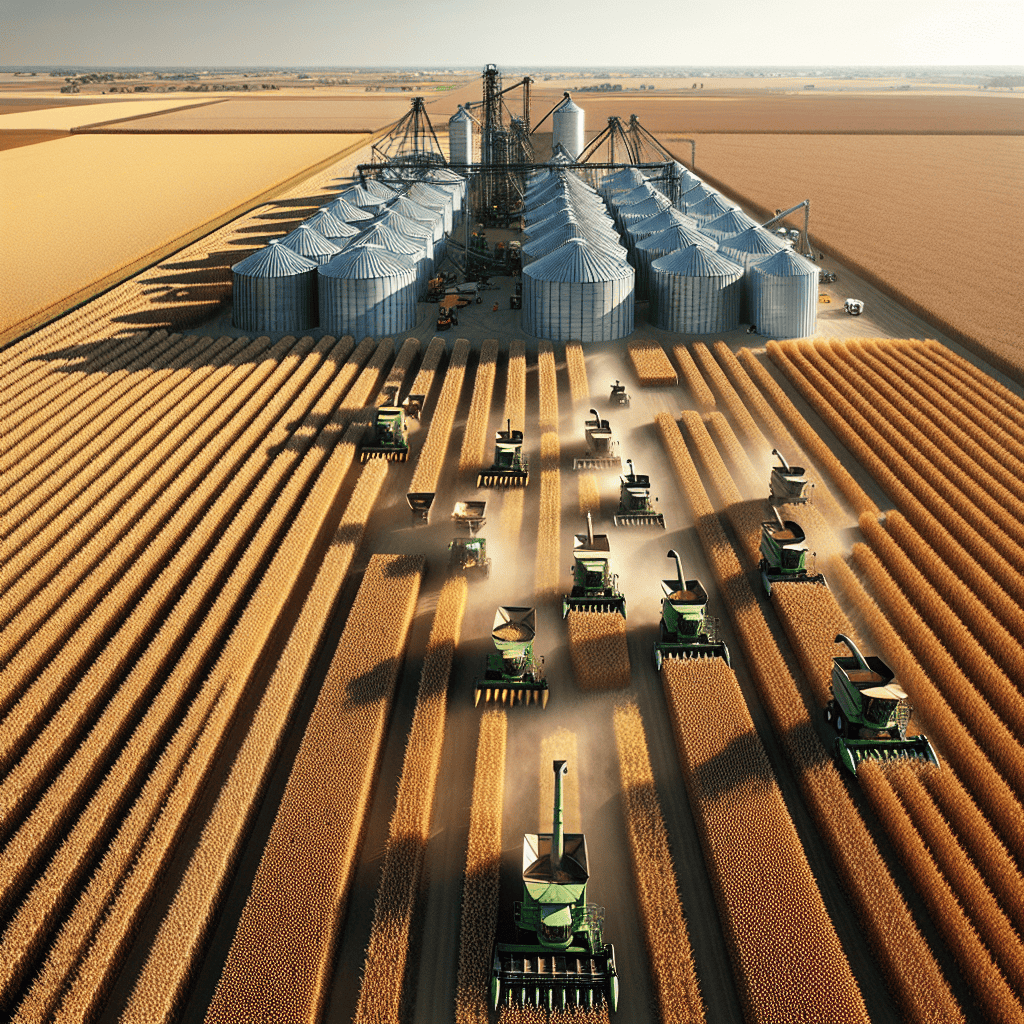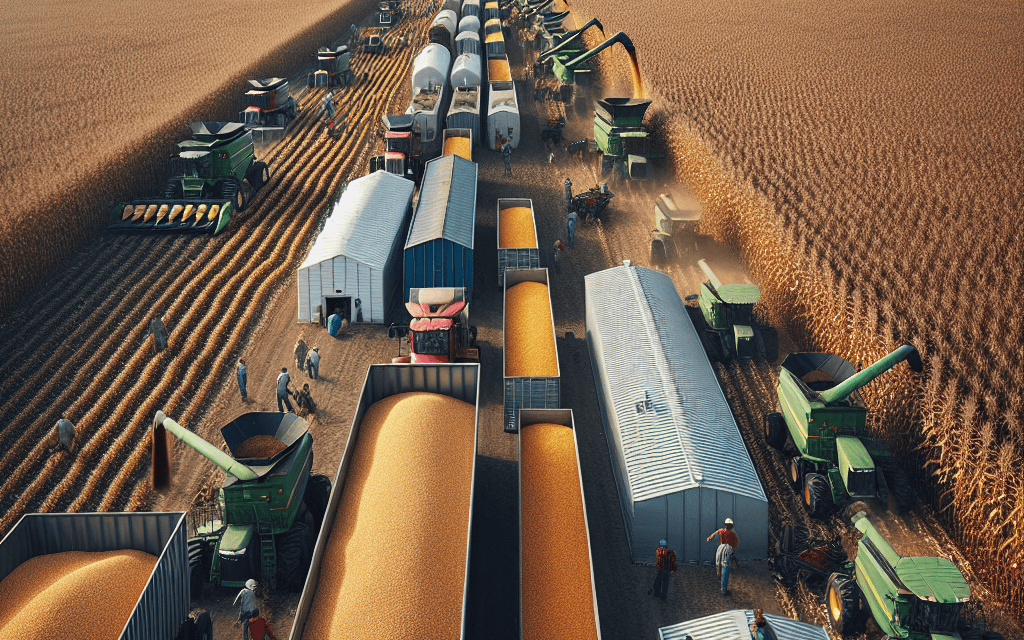“Racing the Clock: Farmers Tackle Overflowing Bounty Amid Storage Strains”
Introduction
The rapid pace of corn and soybean harvests in the United States is presenting significant challenges for farmers and storage facilities. As technological advancements and favorable weather conditions accelerate the harvesting process, farmers are faced with the logistical dilemma of managing and storing the abundant yields. The surge in production has outpaced the capacity of existing storage infrastructure, leading to potential bottlenecks and increased pressure on supply chains. This situation not only threatens to diminish the quality of the crops due to inadequate storage solutions but also impacts market dynamics, as farmers may be forced to sell their produce at lower prices to avoid spoilage. The confluence of these factors underscores the urgent need for strategic planning and investment in storage and distribution networks to accommodate the burgeoning harvests and sustain the agricultural economy.
Impact Of Rapid Harvests On Storage Infrastructure
The rapid pace of corn and soybean harvests in the United States has presented significant challenges to farmers and the existing storage infrastructure. As technological advancements in agricultural machinery and favorable weather conditions have accelerated the harvesting process, the pressure on storage facilities has intensified. This situation has prompted a closer examination of the capacity and efficiency of current storage solutions, as well as the broader implications for the agricultural supply chain.
To begin with, the swift harvests have resulted in an unprecedented influx of crops that need immediate storage. Farmers, eager to capitalize on optimal market conditions, are harvesting their fields at a faster rate than ever before. This urgency is driven by the desire to minimize losses from potential adverse weather conditions and to take advantage of favorable market prices. However, the rapid accumulation of harvested crops has quickly overwhelmed existing storage facilities, which were not designed to accommodate such large volumes in a short period.
Moreover, the limitations of current storage infrastructure have become increasingly apparent. Many storage facilities, particularly those in rural areas, are outdated and lack the capacity to handle the sudden surge in crop volume. This has led to a bottleneck effect, where farmers are forced to seek alternative storage solutions or risk spoilage and loss of quality. In some cases, temporary storage options, such as outdoor piles covered with tarps, have been employed, but these are far from ideal due to exposure to the elements and potential pest infestations.
In addition to the physical constraints of storage facilities, logistical challenges have also emerged. The transportation network, crucial for moving crops from fields to storage or processing facilities, is strained under the increased demand. Railways and trucking services are experiencing delays, further complicating the situation for farmers who need to move their produce quickly. This has highlighted the need for a more integrated and responsive transportation infrastructure that can adapt to the fluctuating demands of the agricultural sector.
Furthermore, the financial implications for farmers are significant. The costs associated with securing additional storage, whether through rental of space or investment in new facilities, can be substantial. For smaller operations, these expenses can be particularly burdensome, potentially affecting their profitability and long-term viability. Additionally, the risk of crop spoilage due to inadequate storage solutions can lead to financial losses, further exacerbating the economic strain on farmers.
In response to these challenges, there is a growing recognition of the need for investment in modernizing and expanding storage infrastructure. Innovations in storage technology, such as improved ventilation systems and climate control, can enhance the capacity and efficiency of existing facilities. Moreover, strategic planning and investment in transportation networks can alleviate some of the logistical pressures faced during peak harvest periods.
In conclusion, the rapid pace of corn and soybean harvests in the United States has underscored the critical need for robust and adaptable storage infrastructure. As farmers continue to navigate the complexities of modern agriculture, addressing these storage challenges will be essential to ensuring the sustainability and resilience of the agricultural supply chain. By investing in infrastructure improvements and embracing technological advancements, the agricultural sector can better manage the demands of rapid harvests and secure its future prosperity.
Strategies For Managing Surplus Corn And Soy
As the United States experiences a rapid corn and soy harvest, farmers are confronted with the dual challenges of managing surplus crops and navigating the limitations of existing storage facilities. This year’s favorable weather conditions have accelerated the harvest timeline, resulting in an unprecedented influx of these staple commodities. Consequently, farmers must employ strategic measures to effectively manage the surplus and mitigate potential losses. One of the primary strategies involves optimizing on-farm storage solutions. Many farmers are investing in additional grain bins or upgrading existing ones to accommodate the increased yield. This approach not only provides immediate relief but also offers long-term benefits by enhancing storage capacity for future harvests. However, the financial burden of such investments can be significant, prompting some farmers to explore alternative solutions.
In addition to expanding storage infrastructure, farmers are increasingly turning to temporary storage options. Utilizing grain bags, for instance, has become a popular method for managing excess crops. These large, flexible bags can be placed directly in the fields, providing a cost-effective and efficient means of storing grain until it can be transported or sold. While this solution offers flexibility, it also requires careful monitoring to prevent spoilage and ensure the quality of the stored grain. Moreover, farmers must consider the logistical challenges associated with transporting grain from temporary storage to market, which can add complexity to the overall management strategy.
Another viable strategy for managing surplus corn and soy involves leveraging market opportunities. Farmers are exploring options such as forward contracting and futures trading to lock in favorable prices and secure buyers for their crops. By doing so, they can mitigate the risks associated with fluctuating market conditions and ensure a steady revenue stream. Additionally, some farmers are collaborating with local cooperatives to pool resources and collectively market their surplus, thereby enhancing their bargaining power and access to larger markets.
Furthermore, diversifying the use of surplus crops can also serve as an effective management strategy. For instance, farmers can explore value-added opportunities such as processing corn and soy into biofuels, animal feed, or other derivative products. This not only helps in reducing the surplus but also opens up new revenue streams and contributes to the sustainability of farming operations. However, pursuing such diversification requires careful planning and investment in processing facilities, which may not be feasible for all farmers.
In light of these challenges, government support and policy interventions play a crucial role in assisting farmers. Programs that provide financial assistance for storage infrastructure improvements or offer incentives for crop diversification can significantly alleviate the burden on farmers. Additionally, facilitating access to export markets through trade agreements and partnerships can help absorb the surplus and stabilize domestic prices.
In conclusion, the rapid corn and soy harvests in the United States present both challenges and opportunities for farmers. By employing a combination of storage optimization, market engagement, and crop diversification strategies, farmers can effectively manage the surplus and navigate the constraints of existing storage facilities. Moreover, with the support of government initiatives and collaborative efforts within the agricultural community, farmers can not only address the immediate challenges but also strengthen their resilience against future fluctuations in crop yields. As the agricultural landscape continues to evolve, adaptability and strategic planning will remain key to ensuring the sustainability and profitability of farming operations.
Economic Implications Of Storage Limitations
The rapid pace of corn and soybean harvests in the United States has brought to light significant economic implications, particularly concerning storage limitations. As farmers work tirelessly to gather their crops, the swift harvest has created a bottleneck in the supply chain, challenging both the agricultural sector and the broader economy. This situation underscores the critical role that storage infrastructure plays in the agricultural industry and highlights the need for strategic planning and investment.
To begin with, the accelerated harvest is largely attributed to favorable weather conditions, which have allowed farmers to collect their crops earlier than usual. While this is generally positive, as it reduces the risk of crop damage from adverse weather, it also means that a larger volume of produce is entering the market simultaneously. Consequently, the demand for storage facilities has surged, leading to a shortage of available space. This shortage is not merely a logistical issue but also an economic one, as it affects the pricing and distribution of these essential commodities.
In light of these storage constraints, farmers are faced with difficult decisions. Some may opt to sell their crops immediately, even if market prices are not optimal, to avoid the costs associated with finding alternative storage solutions. This influx of supply can lead to a temporary decrease in market prices, which, while beneficial for consumers, can reduce profit margins for farmers. On the other hand, those who choose to store their crops in hopes of better prices later may incur additional costs, such as renting storage space or investing in on-farm storage facilities. These financial pressures can strain farmers’ budgets and impact their long-term financial stability.
Moreover, the storage limitations have broader economic implications beyond individual farmers. The agricultural sector is a significant contributor to the U.S. economy, and disruptions in this sector can have ripple effects. For instance, transportation and logistics companies may experience increased demand as they work to move crops to available storage facilities or markets. This can lead to higher transportation costs, which may eventually be passed on to consumers. Additionally, the strain on storage infrastructure can impact the quality of the stored crops, potentially leading to losses if the produce deteriorates before it can be sold.
Furthermore, the current situation highlights the importance of investment in agricultural infrastructure. As the global population continues to grow, the demand for food will only increase, necessitating efficient and effective storage solutions. Public and private investment in storage facilities, transportation networks, and technology can help mitigate the challenges posed by rapid harvests and ensure that the agricultural sector remains resilient in the face of future disruptions.
In conclusion, the rapid U.S. corn and soybean harvests have exposed significant economic implications related to storage limitations. While favorable weather conditions have facilitated an early harvest, the resulting pressure on storage infrastructure has created challenges for farmers and the broader economy. Addressing these issues requires strategic planning and investment to enhance storage capacity and ensure the stability of the agricultural sector. By doing so, the industry can better navigate the complexities of supply and demand, ultimately benefiting both producers and consumers.
Technological Solutions For Efficient Crop Storage

As the United States experiences a surge in corn and soybean harvests, farmers are increasingly confronted with the challenge of efficiently storing these abundant yields. The rapid pace of harvesting, driven by favorable weather conditions and advanced agricultural techniques, has outpaced traditional storage capacities, prompting a critical need for innovative solutions. In this context, technological advancements are playing a pivotal role in addressing the storage conundrum, offering farmers new tools to manage their crops effectively and mitigate potential losses.
One of the primary technological solutions gaining traction is the use of advanced grain monitoring systems. These systems employ sensors and data analytics to provide real-time information on the condition of stored grains. By continuously monitoring temperature, humidity, and other critical parameters, these systems enable farmers to detect and address issues such as spoilage or pest infestations before they escalate. This proactive approach not only preserves the quality of the harvest but also extends the storage life of the crops, thereby reducing waste and enhancing profitability.
In addition to monitoring systems, the adoption of automated aeration systems has become increasingly prevalent. These systems optimize the airflow within storage facilities, maintaining ideal conditions for grain preservation. By automatically adjusting ventilation based on real-time data, they ensure that the stored crops remain dry and cool, which is essential for preventing mold growth and other forms of degradation. The integration of such technology not only improves the efficiency of storage operations but also reduces the labor and energy costs associated with manual monitoring and adjustments.
Moreover, the implementation of smart silos represents another significant advancement in crop storage technology. These silos are equipped with Internet of Things (IoT) devices that provide farmers with remote access to storage data via smartphones or computers. This connectivity allows for seamless management of storage conditions, even from afar, enabling farmers to make informed decisions quickly. The ability to remotely monitor and control storage environments is particularly beneficial during peak harvest periods when time and resources are stretched thin.
Furthermore, the use of blockchain technology is emerging as a promising solution for enhancing transparency and traceability in the grain supply chain. By recording every transaction and movement of the crops on a decentralized ledger, blockchain ensures that all stakeholders have access to accurate and tamper-proof information. This transparency not only builds trust among buyers and sellers but also facilitates more efficient logistics and inventory management. As a result, farmers can optimize their storage strategies based on real-time market demands and trends, ultimately leading to better pricing and reduced storage times.
In light of these technological advancements, it is evident that the integration of innovative solutions is crucial for addressing the storage challenges posed by rapid harvests. However, it is also important to recognize that the successful implementation of these technologies requires investment and training. Farmers must be equipped with the necessary skills and knowledge to leverage these tools effectively. Therefore, collaboration between technology providers, agricultural extension services, and farmers is essential to ensure that these solutions are accessible and beneficial to all stakeholders involved.
In conclusion, as the US continues to experience record-breaking corn and soybean harvests, the pressure on storage capacities will persist. By embracing technological solutions such as advanced monitoring systems, automated aeration, smart silos, and blockchain, farmers can enhance their storage efficiency and safeguard their yields. These innovations not only address immediate storage challenges but also pave the way for a more sustainable and resilient agricultural sector in the long term.
Environmental Concerns With Excess Crop Production
The rapid pace of corn and soybean harvests in the United States has brought to light a series of environmental concerns, particularly regarding the management of excess crop production. As farmers work tirelessly to gather their bountiful yields, they face the dual challenge of efficiently storing these crops while mitigating the environmental impact of surplus production. This situation underscores the intricate balance between agricultural productivity and environmental stewardship, a balance that is becoming increasingly difficult to maintain.
To begin with, the accelerated harvests are largely attributed to favorable weather conditions and advancements in agricultural technology. These factors have enabled farmers to produce record-breaking quantities of corn and soybeans. However, this abundance has led to a pressing issue: the lack of adequate storage facilities. As silos and grain bins reach their capacity, farmers are compelled to seek alternative storage solutions, such as temporary outdoor piles. While these measures provide a short-term fix, they pose significant environmental risks. Exposure to the elements can lead to spoilage and the release of greenhouse gases, contributing to environmental degradation.
Moreover, the surplus of crops has economic implications that further exacerbate environmental concerns. With an oversupply in the market, prices for corn and soybeans have plummeted, prompting some farmers to leave excess crops in the fields. This practice, while economically driven, can have detrimental effects on soil health. Decomposing crops can alter soil composition, potentially leading to nutrient imbalances and increased susceptibility to erosion. Consequently, the long-term fertility of the land may be compromised, posing a threat to sustainable agricultural practices.
In addition to storage and economic challenges, the rapid harvests have intensified the debate over land use and biodiversity. The pressure to maximize crop production often leads to the expansion of agricultural land, encroaching on natural habitats and reducing biodiversity. This loss of biodiversity can disrupt ecosystems and diminish the resilience of agricultural landscapes to pests and diseases. As such, the environmental cost of excess crop production extends beyond immediate concerns, highlighting the need for a more holistic approach to agricultural planning.
Transitioning to potential solutions, it is imperative for stakeholders to collaborate in addressing these environmental challenges. One avenue is the development of more efficient storage technologies that minimize spoilage and environmental impact. Innovations in grain storage, such as hermetically sealed bags and advanced monitoring systems, can help preserve crop quality while reducing greenhouse gas emissions. Additionally, policies that incentivize sustainable farming practices and crop diversification can mitigate the adverse effects of surplus production. By encouraging farmers to adopt practices that enhance soil health and promote biodiversity, the agricultural sector can move towards a more sustainable future.
Furthermore, the integration of precision agriculture technologies offers promising prospects for optimizing crop yields while minimizing environmental impact. By utilizing data-driven insights, farmers can make informed decisions about planting, irrigation, and fertilization, thereby reducing waste and conserving resources. This approach not only addresses the immediate challenges of excess crop production but also contributes to the long-term sustainability of agricultural systems.
In conclusion, the rapid harvests of corn and soybeans in the United States present a complex array of environmental concerns that demand urgent attention. As farmers navigate the challenges of excess crop production, it is crucial to adopt strategies that balance productivity with environmental responsibility. Through innovation, collaboration, and sustainable practices, the agricultural sector can rise to the occasion, ensuring that the bounty of today does not come at the expense of tomorrow’s environmental health.
Market Dynamics In Response To Harvest Surpluses
The rapid pace of corn and soybean harvests in the United States this year has presented a unique set of challenges for farmers and the agricultural market. As the harvest season progresses, the sheer volume of crops being brought in has begun to strain existing storage capacities, prompting concerns about market dynamics and the potential for price fluctuations. This situation is not entirely unprecedented, but the scale and speed at which it is unfolding have caught many in the agricultural sector by surprise.
To begin with, favorable weather conditions throughout the growing season have contributed to an abundant yield of both corn and soybeans. This has been a boon for farmers in terms of production, yet it simultaneously poses logistical challenges. The rapid harvesting process, driven by the need to capitalize on optimal weather windows, has led to a bottleneck in storage facilities. Many grain elevators and silos are reaching their limits far sooner than anticipated, forcing farmers to seek alternative storage solutions or risk leaving crops exposed to the elements.
In response to these storage constraints, some farmers have resorted to temporary measures such as piling grain on the ground, a practice that carries its own set of risks, including potential spoilage and quality degradation. Others are exploring options such as renting additional storage space or utilizing on-farm storage bags. However, these solutions are not without cost, and they add an additional layer of complexity to an already challenging situation.
The implications of these storage issues extend beyond the farm. As storage facilities fill up, the pressure to move grain quickly into the market increases. This urgency can lead to a temporary oversupply, which in turn may depress prices. Farmers, therefore, face the difficult decision of whether to sell their crops immediately at potentially lower prices or to hold out for better market conditions, assuming they have the capacity to store their harvest safely.
Moreover, the transportation infrastructure is also feeling the strain. The increased volume of crops needing to be moved from farms to storage or processing facilities has put additional pressure on rail and trucking services. Delays and logistical challenges in transportation can exacerbate the storage problem, as crops that cannot be moved promptly may contribute to the overflow at storage sites.
In the broader market context, these dynamics have the potential to influence global trade patterns. The United States is a major exporter of corn and soybeans, and fluctuations in domestic supply and pricing can have ripple effects on international markets. Countries that rely on US exports may find themselves adjusting their purchasing strategies in response to changing prices and availability.
In conclusion, the rapid harvest of corn and soybeans in the United States this year has highlighted the intricate balance between production, storage, and market dynamics. While the abundant yield is a testament to the resilience and capability of American farmers, it also underscores the need for adaptive strategies to manage the challenges that come with such success. As the agricultural sector navigates these complexities, stakeholders at all levels will need to collaborate and innovate to ensure that the benefits of a bountiful harvest are fully realized without compromising market stability.
Policy Measures To Support Farmers During Rapid Harvests
As the United States experiences an unprecedented pace in corn and soybean harvests, farmers are facing significant challenges that extend beyond the fields. The rapidity of these harvests, driven by favorable weather conditions and advancements in agricultural technology, has led to a situation where storage capacities are being tested to their limits. Consequently, there is an urgent need for policy measures that can effectively support farmers during these times of abundance, ensuring that the benefits of a bountiful harvest are not overshadowed by logistical and economic hurdles.
To begin with, the swift pace of harvesting has resulted in a glut of produce that exceeds the available storage facilities. This situation is exacerbated by the fact that many storage units are already filled with previous yields, leaving little room for the current influx. As a result, farmers are compelled to seek alternative storage solutions, often at a significant cost. In this context, government intervention could play a crucial role in alleviating the burden on farmers. By providing subsidies or low-interest loans for the construction of additional storage facilities, policymakers can help ensure that farmers have the necessary infrastructure to manage their produce efficiently.
Moreover, the rapid harvests have also led to a bottleneck in transportation logistics. With an overwhelming volume of corn and soybeans needing to be moved to markets or storage facilities, the existing transportation networks are struggling to keep up. This delay not only risks the spoilage of produce but also affects market prices, as the supply chain becomes congested. To address this issue, policy measures could include investments in improving transportation infrastructure, such as railways and highways, which are critical for the efficient movement of agricultural goods. Additionally, temporary measures like prioritizing agricultural shipments could be implemented to ensure timely delivery.
In addition to infrastructure and logistics, market dynamics also play a significant role in the challenges faced by farmers during rapid harvests. The sudden increase in supply can lead to a drop in market prices, adversely affecting farmers’ incomes. To mitigate this, government policies could focus on stabilizing prices through strategic reserves or by facilitating export opportunities. By purchasing excess produce for reserves, the government can help maintain price levels, providing farmers with a more predictable income stream. Furthermore, expanding international trade agreements could open new markets for US corn and soybeans, helping to absorb the surplus and stabilize domestic prices.
Another critical aspect of supporting farmers during rapid harvests is ensuring access to timely and accurate information. Farmers need to make informed decisions about when to harvest, store, or sell their produce. Therefore, enhancing agricultural extension services and investing in technology that provides real-time data on market trends, weather forecasts, and storage capacities can empower farmers to optimize their operations. Policymakers can facilitate this by funding research and development initiatives that focus on precision agriculture and data analytics.
In conclusion, while rapid corn and soy harvests present significant challenges, they also offer an opportunity for policymakers to implement measures that can strengthen the agricultural sector. By focusing on infrastructure improvements, market stabilization, and information dissemination, government interventions can provide the necessary support to farmers, ensuring that they can navigate the complexities of a bountiful harvest successfully. Through these efforts, the agricultural industry can continue to thrive, contributing to the broader economic stability and food security of the nation.
Q&A
1. **Question:** What factors are contributing to the rapid corn and soy harvests in the US?
– **Answer:** Favorable weather conditions and advancements in agricultural technology are contributing to the rapid pace of corn and soy harvests.
2. **Question:** How are farmers being challenged by the rapid harvests?
– **Answer:** Farmers are facing logistical challenges, including a shortage of storage facilities and transportation bottlenecks, due to the accelerated pace of the harvests.
3. **Question:** What impact does the rapid harvest have on storage facilities?
– **Answer:** The rapid harvest is leading to storage limits being reached quickly, causing a strain on available storage capacity and forcing some farmers to store crops in less-than-ideal conditions.
4. **Question:** How are transportation networks affected by the rapid harvests?
– **Answer:** Transportation networks are experiencing congestion and delays as they struggle to keep up with the increased volume of crops needing to be moved from farms to storage or processing facilities.
5. **Question:** What economic implications do the rapid harvests have for farmers?
– **Answer:** Farmers may face lower prices for their crops due to the oversupply in the market, and increased costs associated with finding alternative storage solutions or dealing with transportation delays.
6. **Question:** What strategies are farmers employing to cope with storage limitations?
– **Answer:** Farmers are utilizing temporary storage solutions such as grain bags, renting additional storage space, or selling crops directly from the field to manage the overflow.
7. **Question:** How might these challenges affect future planting and harvesting decisions?
– **Answer:** These challenges may lead farmers to reconsider their planting schedules, crop choices, or investment in on-farm storage infrastructure to better manage future harvests.
Conclusion
The rapid pace of the U.S. corn and soybean harvests presents significant challenges for farmers and storage infrastructure. As farmers work to quickly bring in their crops, they face logistical hurdles in managing the sheer volume of produce. The accelerated harvest can lead to bottlenecks in transportation and storage, as existing facilities may not have the capacity to accommodate the influx. This situation can result in increased costs for temporary storage solutions or potential losses if crops are not stored properly. Additionally, the pressure to move crops quickly can strain supply chains and impact market prices. To mitigate these challenges, investments in expanding storage capacity and improving supply chain efficiency are crucial. Farmers may also need to explore alternative storage options and collaborate with local cooperatives to optimize resources. Overall, while rapid harvests can boost productivity, they necessitate strategic planning and infrastructure enhancements to ensure that the benefits are fully realized without incurring unnecessary losses.





